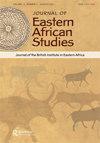“文明工程”与南苏丹伊斯兰主义者:在同化与排斥之间
IF 0.6
3区 社会学
Q2 AREA STUDIES
引用次数: 0
摘要
摘要:本文通过采访和与苏丹伊斯兰运动有关的各种报纸和其他媒体,分析了苏丹南部独立地区伊斯兰化战略的历史发展,特别参考了该地区伊斯兰运动成员的经历。它指出了殖民时期和伊斯兰教“教化”南苏丹人的设计之间的重要相似之处,认为像其殖民时期的前身一样,哈桑·图拉比的“拯救政权”的“文明工程”在同化和排斥他们之间交替进行。1989年后的伊斯兰政权在2011年南方分离前后对待南方伊斯兰教徒的方式,突显了同化主义和排斥主义趋势之间的分歧。尽管该运动在招募南方成员方面基本上是失败的,但那些真正加入的人并不仅仅是伊斯兰主义的附庸——就像来自其他边缘地区的伊斯兰主义者一样,他们试图利用该运动跨越中心和边缘之间的社会鸿沟,有时以一种挑战主导该运动的河流精英的方式。通过解构伊斯兰运动在意识形态和社会上同质的概念,本文为有关苏丹阿拉伯化和伊斯兰化以及后殖民背景下中心-边缘关系的辩论提供了一个新的视角。本文章由计算机程序翻译,如有差异,请以英文原文为准。
The “Civilizational Project” and the southern Sudanese Islamists: between assimilation and exclusion
ABSTRACT Drawing upon interviews and a variety of newspapers and other media associated with the Sudanese Islamic Movement, this article analyses historic developments in its strategy for the Islamization of the now independent region of southern Sudan with particular reference to the experience of members of the movement from that region. It identifies significant parallels between the colonial and Islamist designs for “civilizing” southern Sudanese, arguing that like its colonial predecessor the “Civilizational Project” of Hasan al-Turabi’s “Salvation Regime” alternated between assimilating and excluding them. The post-1989 Islamist regime’s treatment of Islamist southerners before and after the secession of the south in 2011 highlighted the division between these assimilationist and exclusionary trends. Although the movement was largely unsuccessful in recruiting southern members, those who did join were not simply Islamist satellites – like Islamists from the other marginalized regions, they sought to use the Movement to traverse the social divide between center and periphery, sometimes in a manner that challenged the riverain elites that dominated it. In thus deconstructing the notion that Islamic movements are ideologically and socially homogenous, the article contributes a fresh perspective on the debate about Arabization and Islamization in Sudan as well as center–periphery relations in post-colonial contexts.
求助全文
通过发布文献求助,成功后即可免费获取论文全文。
去求助
来源期刊

Journal of Eastern African Studies
AREA STUDIES-
CiteScore
3.30
自引率
7.10%
发文量
12
期刊介绍:
Journal of Eastern African Studies is an international publication of the British Institute in Eastern Africa, published four times each year. It aims to promote fresh scholarly enquiry on the region from within the humanities and the social sciences, and to encourage work that communicates across disciplinary boundaries. It seeks to foster inter-disciplinary analysis, strong comparative perspectives, and research employing the most significant theoretical or methodological approaches for the region.
 求助内容:
求助内容: 应助结果提醒方式:
应助结果提醒方式:


